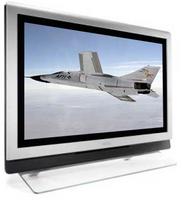Philips 42PF9966/37
 Rich colors, bright images, and good detail helped the 42PF9966/37 earn the second-highest overall score in our jury tests of eight plasma TVs. We awarded it top marks for color quality and its ability to display both standard definition TV and DVDs.
Rich colors, bright images, and good detail helped the 42PF9966/37 earn the second-highest overall score in our jury tests of eight plasma TVs. We awarded it top marks for color quality and its ability to display both standard definition TV and DVDs.Despite its high display performance, however, this Philips has a few quirks. For starters, it's fussy about input formats. Using both 1080i and 480p input over HDMI, the TV struggled to display so-called multiburst patterns. The multibursts feature six swaths of parallel vertical lines that become progressively finer from the left to the right of the screen. Most TVs could resolve all the groups, or at least all but the far-right group, which sometimes blurred out. But on this TV, image quality started breaking down at the first group on some screens, and the far-right swath often looked like a swarm of mosquitoes. And in one of our HD test clips from a classic car show, we saw an artificial shimmering effect in the chrome bars of a sports car. Overall, though, our jury noticed no significant problems with the HDTV and DVD content in our test suite.
The TV did display a multiburst perfectly in the 720p format. Unlike any other TVs we reviewed, the Philips displays this format with its native 720 lines. Other TVs "upscale" the content by inserting additional pixels to fill the screen to the edges. But on the Philips, 720p images appear with a black border on the top and the bottom, as well as on both sides (in order to maintain the aspect ratio).
The audio system, with twin 15-watt speaker units, sounded clean, though not as full as on the rival LG 42PX4D. We especially liked the five-band equalizer, which allows more meaningful adjustments than the simple bass and treble controls on most TVs. In addition, the 42PF9966/37 provides four preset audio modes.
The Philips model's most unusual feature is its Ambilight system, which illuminates the wall behind the TV. The Ambilight throws "bias lighting" behind the set; videophiles recommend bias lighting as a method for reducing eyestrain in a dark room. Without it, so goes the theory, the iris must expand and contract rapidly in reaction to the changing brightness level of the video.
Some eye experts discount the eyestrain theory, saying that the eye can easily adjust to brightness fluctuations without experiencing strain. But regardless of the science, we found the Ambilight experience pleasant. A dark room seemed less confining with the mild glow around the set, and glancing away from and then back to the screen had a less jarring effect. In addition to providing several fixed shades, Ambilight can adjust its color and brightness to match the material on screen. Users who don't enjoy the Ambilight feature can disable it.
The list of remaining amenities is scant. The 42PF9966/37 has an integrated NTSC tuner for standard-definition analog broadcasts, but it lacks an ATSC tuner for receiving over-the-air or cable-based digital signals. You'll need a separate receiver for digital cable or for HDTV. The unit has only one HDMI input, too, so you won't get top quality for more than one video source; you have to use the two analog component sets for other devices. You can custom calibrate for each video input, but for only one set of lighting conditions, as the other five video modes are not user adjustable. However, the set does have a sensor that it can use to adjust the screen to match the ambient room light.
Upshot: The 42PF9966/37 offers very high overall picture quality at a relatively low price. But it would be more appealing with an HD tuner and an extra digital video input.
Source: pcworld





